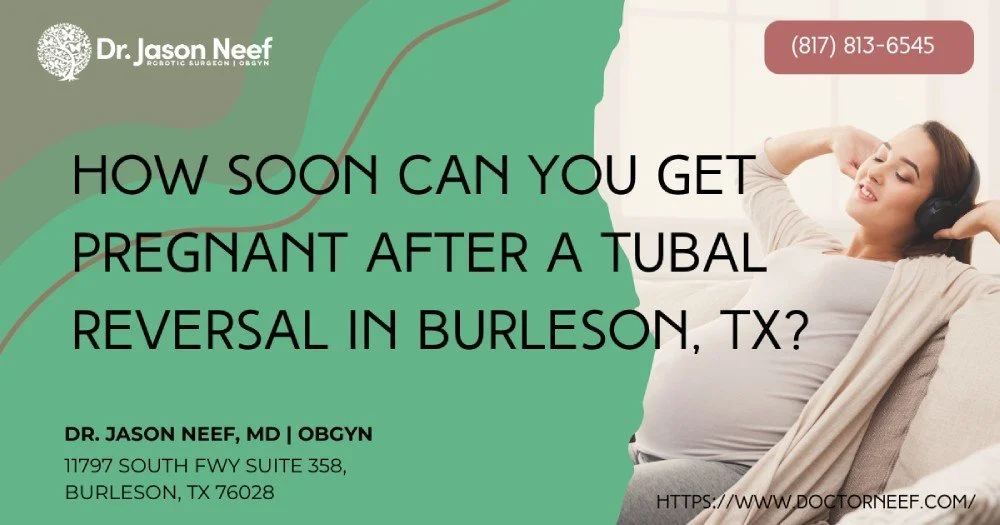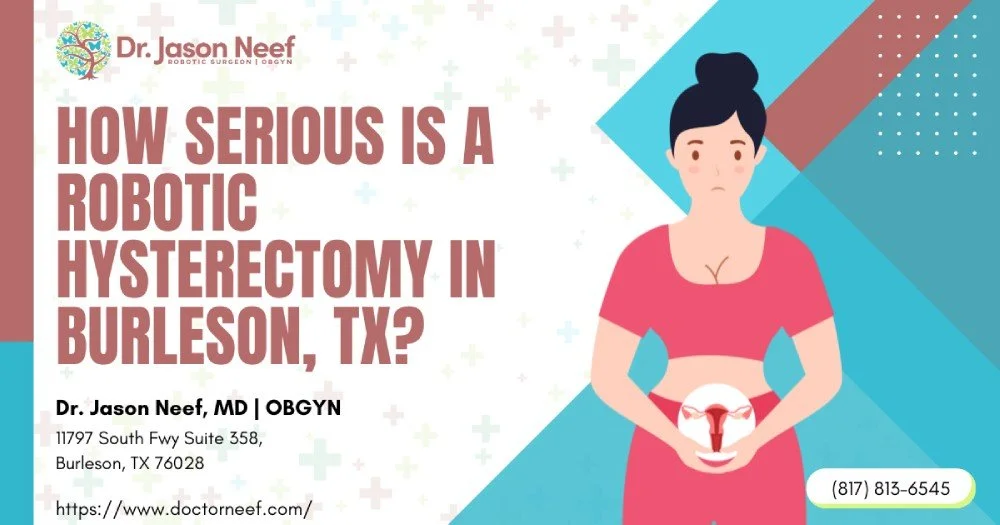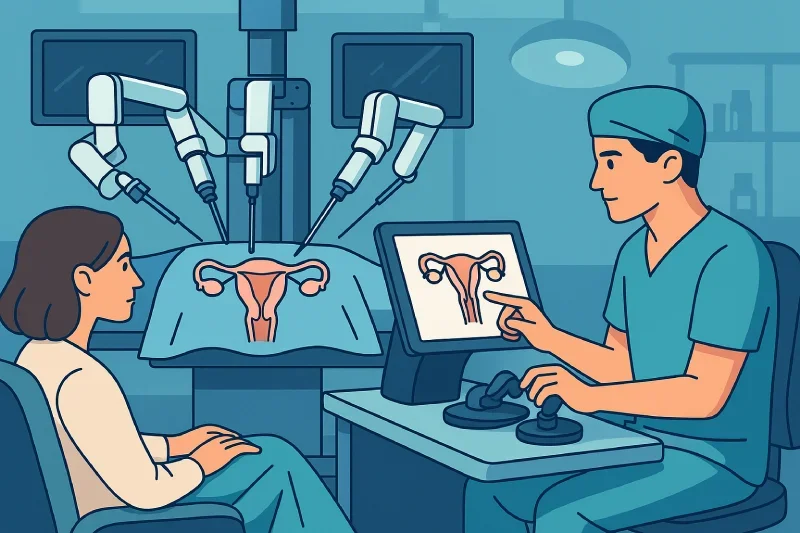How Soon Can You Get Pregnant After a Tubal Reversal in Burleson, TX?
Categories:
By: Ethan Cole
Tubal reversal offers Johnson County women a second chance at natural conception after a prior tubal ligation, but everyone wants to know, “How fast will I conceive?” National data tell us that the chance of becoming pregnant after a successful tubal reversal in a woman under age 35 is 60–80% over a two-year period. In many Fort Worth-area practices, half of those pregnancies arrive during the very first year. Your exact timeline depends on age, tube length, the type of tubal ligation procedure originally performed, and overall reproductive health.
Below, we unpack each variable, highlight local resources, and explain when alternative fertility treatment—most commonly IVF—may be the smarter path. Whether you had your tubes tied at Lake Worth, Cleburne, or downtown Fort Worth, this guide will help you map out the months ahead with confidence.
Key Takeaways
Surgical success + biological age set the clock. Women under 35 with at least 4 cm of healthy tube on each side often conceive within 6–12 months; patients over 38 or with shorter segments may need up to 24 months or consider IVF sooner.
Early cycles are golden: Nearly half of all pregnancies following tubal ligation reversal occur in the first two ovulatory cycles, so track LH surges and schedule intercourse strategically.
Lifestyle still matters. Smoking, high BMI, or a borderline semen analysis can double time-to-pregnancy even after a technically perfect tubal surgery.
Know when to pivot. Reproductive endocrinology and infertility specialists advise switching to in vitro fertilization if no conception occurs after 12 cycles (under 35) or 6 cycles (over 38).
North Texas help is close. From Baylor Scott & White labs to Care Fertility clinics and Worth Fertility support groups, leveraging hometown resources shortens your path to a positive test.
Understanding Tubal Reversal Surgery and Recovery
Eighty-word intro: Tubal reversal—also called tubal ligation reversal, tubal re-anastomosis, or simply “tubal surgery”—restores the natural corridor between ovary and uterus by reconnecting the divided sections of the fallopian tube. The procedure gives many couples an appealing alternative to in vitro fertilization because eggs can once again meet sperm inside the tube, allowing fertilization and embryo travel to occur exactly the way nature intended.
What Happens During Surgery?
The surgical procedure is performed under general anesthesia through a 2–3-inch bikini-line incision or, in select cases, a mini-laparoscopy.
Using a microscope and other microsurgical techniques, your surgeon excises scarred sections of the fallopian tube, aligns the healthy ends, and places microscopically fine sutures to rejoin the layers.
A blue-dye patency test confirms the tubes are clear before closure.
Total operative time is 60–90 minutes, and most patients spend under two hours in the recovery room before heading home.
Post-Op Healing Timeline
|
Post-Op Day |
What’s Happening |
Tips for Faster Recovery |
|
1–3 |
Mild cramping, grogginess |
Short walks, hydrate; arrange child care 14 days prior to surgery so you can truly rest |
|
4–7 |
Energy returning, incision soreness |
No lifting > 10 lbs; light emails okay |
|
8–14 |
Incision itching, minimal spotting |
Resume desk work; keep wound clean |
|
15–30 |
Internal stitches dissolve; tubes seal |
Gentle stretching, pelvic floor exercises |
|
30–45 |
First spontaneous ovulation likely |
Begin basal body-temperature charting |
Cost, Insurance & Pre-Op Prep
Professional + hospital fee in Burleson or Lake Worth: $6,500–$9,000.
Most carriers label reversal permanent birth control “elective,” but some cover diagnostic portions—verify prior to surgery.
Budget $500–$1,200 for pre-op labs, semen analysis, and a follow-up HSG.
Schedule a “report from your tubal ligation” review: the operative note from your original ligation procedure helps the surgeon predict chances of success.
Explore your fertility options—get expert guidance near Fort Worth.
Call (817) 568-8731Key Factors That Influence How Quickly You Can Conceive
Seventy-word intro: Open tubes alone do not guarantee pregnancy success. You still need healthy eggs, robust sperm, a welcoming uterine lining, and precise timing. The factors below determine whether you celebrate a positive test after just a few cycles or require additional fertility treatment such as IUI or IVF.
Age & Ovarian Reserve
Egg quality declines gradually after 32 and accelerates after 37. An AMH test above 1 ng/mL and day-3 FSH below 10 mIU/mL indicate good ovarian reserve. Poor reserve doesn’t negate reversal but may shorten the window before moving to in vitro fertilization.
Length and Location of Tubal Reconnection
≥ 4 cm of tube: Highest pregnancy rate—natural fertilization zone intact.
2–3.9 cm: Moderate odds; allow 12–18 months of trying to conceive.
< 2 cm or fimbrial repairs: Consider IVF backup within six months.
Partner’s Semen Parameters
A semen analysis evaluates count, motility, and morphology. Counts under 20 million or motility under 40% can double the trying timeline. Zinc, vitamin C, boxer shorts, and quitting tobacco often boost numbers within three months.
Type of Tubal Ligation & Operative Damage
Clips or rings preserve more length than cautery or fimbriectomy. Long burns decrease the candidate’s chance of pregnancy because fewer sections of the fallopian tube remain to stitch together. Discuss your prior ligation procedure with your surgeon.
General Health & Lifestyle
BMI 20–30 supports regular ovulation.
Smoking thickens cervical mucus and raises ectopic pregnancy risk.
Excess caffeine (> 300 mg) may impair implantation.
High stress elevates cortisol; yoga and walking bring levels down.
How Soon After Tubal Reversal Can You Conceive Naturally?
Eighty-word intro: Although statistics quote a two-year period, most North Texas patients conceive on a predictable curve. Understanding each milestone keeps you motivated, highlights potential red flags, and guides when to book a fertility specialist consult.
Months 1–3: The Optimistic Phase
Roughly 50% of all post-reversal pregnancies happen here.
Track LH daily; have intercourse every other day during the fertile window.
Mild twinges around ovulation indicate tubes and ovaries are interacting normally.
Months 4–6: Cycle Fine-Tuning
Test day-21 progesterone; supplement if < 10 ng/mL.
HSG at month 6 confirms both tubes remain open.
Start or continue prenatal vitamins with 400–800 mcg folate and omega-3s.
Months 7–12: Time for Deeper Testing
Repeat semen analysis at month 9 if no conception.
Evaluate thyroid (TSH 1–2 mIU/L) and prolactin.
Saline sonogram can locate hidden polyps or fibroids.
Year Two and Beyond
Under 35: consider IVF after 12 cycles.
35–38: evaluate at 6–9 cycles.
Over 38: a fertility specialist may recommend skipping directly to IVF to maximize pregnancy success rates before egg quality declines further.
Optimizing Your Fertility in Burleson, Fort Worth & Lake Worth
Eighty-word intro: Excellent surgical skill is half the battle; local support services fill in the rest. From healthy produce at the farmers’ market to high-tech imaging at Baylor, Burleson offers everything you need to shorten the road to a healthy embryo and ongoing pregnancy.
Choosing the Right Surgeon
Confirm board certification in reproductive surgery or obstetrics & gynecology with fertility subspecialty.
Ask about pregnancy success rates—not just tubal patency.
Ensure the center uses a microscope for all reconnections; research shows microsurgical approaches improve chances of success.
Local Labs & Fertility Centers
Baylor Scott & White Medical Center: early-morning hormone panels with same-day results.
Lone Star Radiology in Old Town: low-dose HSG imaging.
Care Fertility and Texas Fertility Center–Fort Worth campus offer advanced reproductive endocrinology and infertility services, including IVF if you decide to pivot.
Nutrition, Fitness & Stress Management
Burleson Farmers Market stocks folate-rich greens and antioxidant berries.
Camp Gladiator and YMCA’s low-impact sessions are ideal when returning to work and exercise post-reversal.
Meditation groups at Worth Fertility Support meet Thursdays to lower stress.
Community & Counseling
Resolve.org lists a Fort Worth-Burleson infertility peer group meeting monthly at the library.
Faith-based counseling near Lake Worth offers sliding-scale sessions for couples coping with prolonged infertility or an ectopic or tubal pregnancy loss.
When to Consider IVF After Tubal Reversal
Eighty-word intro: Even after successful tubal surgery, some couples will still battle unexplained infertility, low ovarian reserve, or severe male-factor issues. Knowing when to transition to assisted therapy prevents wasted months and heartache.
IUI vs. IVF After a Successful Tubal Reversal Procedure
Intrauterine insemination (IUI): By-passes cervical mucus but still relies on clear tubes; success 10–15% per cycle.
In vitro fertilization (IVF): Completely sidesteps tubes; success 50–60% per retrieval in women under 35, 30–40% at ages 37–40.
Local Cost Snapshot
|
Treatment |
Average North Texas Cost |
Best For |
|
IUI (with meds) |
$1,000–$1,500 |
Open tubes, mild male-factor, cost concerns |
|
IVF |
$12,000–$15,000 + meds |
Short tubes, age > 38, repeat ectopic, desire chromosomal testing |
Deciding When to Transition
Under 35: evaluate IVF after 12 failed cycles.
35–38: pivot at 6–9 cycles.
Over 38: many fertility centers suggest pairing reversal with an IVF contingency plan before surgery is performed.
Schedule your tubal reversal consultation with Dr. Neef today.
Call (817) 568-8731Categories:
Frequently Asked Questions
-
Many women conceive within the first 6–12 months, with about half of pregnancies occurring in the first year. Age, tubal length, and overall fertility health determine whether success happens early or requires more time.
-
Women under 35 often see 60–80% success within two years, while rates decline after age 38. Tube length and ovarian reserve are also critical factors. Discuss your specific odds with your fertility specialist for a realistic estimate.
-
If pregnancy hasn’t occurred within 12 cycles for women under 35—or after 6 cycles for women over 38—most fertility specialists recommend evaluating IVF. This approach maximizes time efficiency before egg quality further declines.
-
Many women conceive naturally, but if ovulation is irregular, mild oral medications such as letrozole can shorten time-to-pregnancy. Your fertility specialist will base this decision on ovarian reserve testing, cycle length, and how many months you’ve already been trying.
-
Reversal reconnects the tubes, so you’ll need alternative contraception once your family is complete. Many couples later choose a hormone-free IUD because it avoids another surgical procedure and preserves fertility in case they change their minds again.
-
While a single IVF cycle can carry a higher per-cycle success rate, tubal surgery is typically cheaper if you hope for more than one child. A successful reversal lets you get pregnant multiple times without paying for repeated embryo transfers.
-
A C-section doesn’t usually affect the tubes themselves, but pelvic adhesions may complicate surgery. During the operative repair, your surgeon can lyse scar tissue, which may actually improve fertility compared with leaving adhesions untouched.
-
Yes. The small abdominal incision heals fully, and the uterus is untouched. Unless you have obstetric indications like placenta previa, you can plan for vaginal birth. Always discuss delivery plans with your obstetrician once you’re pregnant.
-
Yes. Facilities such as Dr. Jason Neef’s practice in Burleson, Care Fertility in Dallas-Fort Worth, and Texas Fertility Center employ surgeons trained in microsurgical techniques using an operating microscope, which elevates pregnancy success rates compared with conventional suturing.
-
Maintain a BMI between 20 and 30, quit smoking, limit caffeine to under 200 mg daily, and aim for 150 minutes of moderate exercise weekly. Include antioxidant-rich foods like berries and leafy greens, and ensure your partner supports healthy sperm by limiting alcohol and heating to the groin area.













